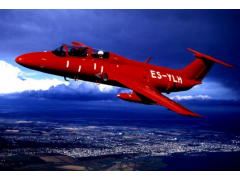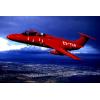Being of a totally new design (unlike the British concept at the time of putting a jet into the piston airframe of the provost) a tandem seating position was chosen with the best wing for subsonic flight, the straight wing. The wing has the ability to carry two of the following:- 150 lts dro tanks (normal use), 100 kg bombs, pods each containing four 67mm rockets or two pods of 7.62mm machine guns. While on the subject of explosive devices both cockpits have ejector seats for use up to 800 kph , a coloured flare system at the rear of the fuselage and a destructive charge in the nose to destroy the IFF unit.
The maximum speed with underwing stores is 0.7 mach and 0.75 without, while “G” limits being +8 -4 all this in an aircraft weighing just over 3,500 KGs. The empanage is the “T” tail much like the Paris Jet, in fact the Paris jet is much the same size but with 4 seats and is certified with a normal category C of A. an aircraft that is long forgotten I feel.
The fuselage has a single engine breathing from an intake in each wing root. This is mounted about mid way and towards the rear of the wing. The Motorlet M-701c-500 turbojet rated is at 1,960 lbs. thrust. The M-701 is an early generation jet engine and features a single stage centrifugal compressor driven by a single stage axial flow turbine. 100% RPM is 15,300, this gives a whistling sound a bit like the fouger magister of similar vintage. There are 7 combustion chambers mounted around the engine. (see photo)
Access to the engine for maintenance at 200 hrs requires the dismounting of the rear fuselage, this sounds a big job but it is facilitated by the removal of bolts in the tail surfaces control rods. A few electrical connections and eight bolts separate the fuselage. Time for this works is 2 persons 2 1/2 hrs. All other maintenance can be carried out through the access panels.
As with all other FSU aircraft the L-29 is made from anodised aluminium. This being the standard in the East as opposed to the Western philosophy of using Al clad materials. The difference being anodising chemically changes the surface to resist corrosion and Al clad is process that puts a thin coat of pure aluminium onto the surfaces. The exception to aluminium skinning is the rudder and elevators. These have a material that is high in magnesium. Magnesium is a material that will dissolve in water over time so it is not uncommon for these surfaces to show signs of corrosion. In fact these areas are the only ones that corrosion has been found on the aircraft imported so far. Beech in the USA went through a phase of using magnesium rich materials on tail surfaces also at about the same time. It represented a weight saving of 120 grams!!
Luggage space is very restricted with a small area in the noise section and soft bag stowage under the seat and a little bit tucked under the elbows on the consuls.





